It’s no secret that AI was the fastest-growing trend in 2024. From early 2022 to 2024, the AI market grew by 48.39% and reached $184 billion. Today, more and more businesses are implementing this technology in their processes. If you also want to benefit from AI or learn more about its type, you are in the right place.
In this article, we will compare the state of generative AI vs predictive AI in 2025. Below, you will find:
So, let’s get started!
Generative AI creates new content, such as text, images, or music, by learning patterns from existing data. Predictive AI, on the other hand, analyzes historical data to forecast future outcomes. The main difference between generative AI and predictive AI lies in the output results. While generative AI focuses on content creation, predictive AI focuses on data analysis and prediction.
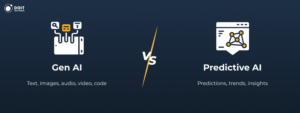
Here is a comparison table for the types of AI: generative vs. predictive.
Definition
Creates new data based on learned patterns
Predicts future outcomes based on historical data
Output types
Text, images, audio, video, code
Predictions, trends, insights
Key technologies
GANs, VAEs, LLMs
Regression Analysis, Decision Trees, SVMs, LSTM, ARIMA
Current market size (2024)
$36 billion
$18.2 billion
Future market size (2033)
$356.1 billion
$52.6 billion
To determine which of these two to implement in your business, you need to know more than their definitions. Below is a detailed overview of generative AI vs predictive AI. Read on!
As mentioned above, generative AI creates new content, such as text, images, music, video, and even facilitates tools like an audio translator that help to convert spoken language into different languages in real-time. Unlike AI prediction models that make decisions based on existing info, generative AI builds new data similar to the ones it learned from.
In this section, you’ll find a detailed overview of GenAI mechanisms, use cases, benefits, and risks.
Generative AI uses machine learning systems, models, algorithms, and neural networks. They usually go through 3 main stages: training, customization (or fine-tuning), and generation. For businesses exploring generative AI in testing, this technology offers powerful capabilities for creating and analyzing test scenarios, optimizing processes, and improving overall efficiency.

First, AI experts create a foundation model. They train it using vast amounts of raw, unstructured data. This way, they perform and test millions of prediction exercises. The result is a neural network of parameters that encodes data patterns.
After that, the model receives labeled data specific to the content generation task. For example, developers use common queries and answers to create a customer service chatbot. Human users then test the created content and provide feedback, which the model uses to improve accuracy.
The primary GenAI methods include:
The finished models also continue to learn from user feedback. Generative AI constantly updates and increases the database’s size. For example, ChatGPT’s open model GPT-3.5 had data only until September 2021, while GPT-4o is now updated until October 2023.
Learn how vetted prompt engineers can help you design and implement LLM-powered solutions tailored to your use case.
The rapid growth of GenAI affects almost every business. Notably, 1 in 5 organizations have already implemented generative AI solutions in production.
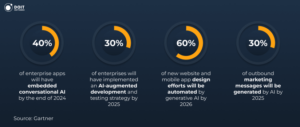
Based on Gartner, 90% of executives believe that IT departments will benefit the most from this technology. Business process automation forecasts suggest that AI will change 70% of initiatives in the design and development of new web and mobile apps. Also, 75% of enterprise software developers will use AI assistants to write code by the end of 2028.
At the moment, we can note the following business departments that are investing in GenAI solutions the most:
Looking back at 2023, here are the most commonly used generative AI functions in enterprises:
While predictive AI is still in the lead, with 32% of companies using it for data analysis, generative AI is gaining more traction, with 26% in writing tasks, according to Statista.
Generative AI offers many benefits but comes with certain risks that businesses must consider.
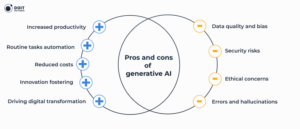
As of 2024, about 56% of enterprises expect increased productivity and efficiency from adopting GenAI. Among the most hoped-for benefits also are:
Anyway, forecasts say that GenAI will have a great impact on the workforce’s digital transformation. 75% of organizations expect the technology to affect their talent management strategies within 2 years. The most anticipated outcomes are process redesign (48%) and upskilling or retraining (47%).
In 2024, businesses still cite the disadvantages of generative AI as the main barrier to adoption. In a recent Google survey, 70% of attendees worry that AI gives wrong information. 68% also say about bias in AI-generated results. Furthermore, 41% cite errors and hallucinations as significant issues.
As a result, more and more businesses are implementing AI-related risk management. Almost half of companies track regulatory requirements and ensure AI compliance. Other popular activities include:
Besides, there are concerns among employees about job losses due to GenAI’s impact. But, in the short term, 39% of organizations said they expect technology to increase headcount rather than decrease it (22%). This is because companies face both a growing need for generative AI and human expertise related to it.
As mentioned above, predictive AI analyzes historical data to forecast future outcomes. In this section, we’ll discuss how this technology works, its use cases, and pros & cons.
Predictive models also work based on machine learning systems. However, predictive AI vs generative AI uses advanced statistical algorithms.
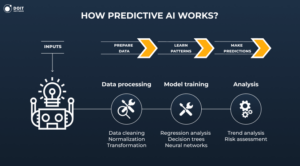
To start, you need to enter the data you want to analyze. For example, provide data on sales, customer behavior, climate conditions, etc. Keep in mind that AI predictors are already configured to work with specific data types, so it is important to use the appropriate format.
Then, the model pre-processes your data. It can remove gaps, normalize data, and cut any anomalies. Next, predictive artificial intelligence provides graphs, tables, or infographic results. For example, it can predict future sales, equipment wear and tear duration, etc.
Predictive AI has a wide range of applications across worldwide businesses. Most often, it involves data analytics in different sectors. Here are some of the most popular cases:
Besides the above, firms often use predictive AI for inventory and supply chain management. This technology helps to analyze product stocks, forecast demand, and calculate delivery time. Businesses can decide which logistics channel to choose, how often to make deliveries, etc.
Predictive AI also has a unique spot in the healthcare industry. For example, the system can analyze the condition of a patient’s disease based on tests and medical history. However, in this case, businesses need to prepare AI for regulatory frameworks such as HIPAA.
Like GenAI, predictive AI also offers the flexibility to automate specific business functions. While in the first case, we talked more about content creation, chatbots, etc., here, the benefits focus on data analysis. However, when comparing Gen AI vs predictive AI, this type has fewer concerns in the business community.
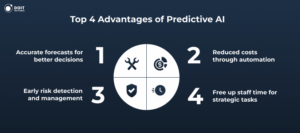
Here are the main benefits of implementing predictive AI in your company:
In generative AI vs predictive AI, the latter is much more prevalent in demand forecasting, data management, and fraud detection. The market offers a wide range of tools for different sectors, so almost every business can benefit from this technology.
While there are many benefits, it’s also necessary to consider the potential drawbacks.
Despite these challenges, the benefits of predictive AI can outweigh the drawbacks. If businesses address these challenges, they can use predictive AI to drive innovation.
As a bonus, there are some of the best examples of generative AI. In the list below, we’ve collected tools for generating text, images, video, audio, and code one by one. Keep reading!

Price: Free; Plus subscription starts at $20/month
App Store: 4.9 (944.6k Reviews)
Google Play: 4.8 (2.35m Reviews)
ChatGPT, developed by OpenAI, is a multipurpose language model that integrates text, voice, and vision capabilities. The platform supports over 50 languages and has over 1.5 billion visits per month. GPT-4o can analyze data and photos and create graphs. Users can now communicate via voice chat and create images with integrated Dall-E.
Key features:

Price: Starts at $10/month
Rating: 4.4 (85 Reviews)
MidJourney is a generative AI for image creation from text prompts. As of July 2024, the tool had 20.66 million registered users on its Discord server. It uses sophisticated AI algorithms to produce detailed and unique visuals across various artistic styles. Users can create digital art, illustrations, and marketing visuals. The platform features a user-friendly interface with easy prompt input.
Key features:

Price: Free for 30 generations per month; Standard plan starts at $29.99/month
Dream Machine, created by Luma, is an AI model that makes videos from text and images. The platform, developed in collaboration with Amazon Web Services (AWS), uses top-tier training infrastructure H100 and SageMaker HyperPod. It generates 5-second shots with realistic, smooth motion, cinematography, and drama. Dream Machine produces 120 frames in just 120 seconds.
Key features:

Price: Free basic plan; subscriptions start at $10/month
App Store: 4.4 (113 Reviews)
Suno is a generative AI music creation program. It makes songs from text inputs like lyrics and descriptions. Users can also create songs from their audio files, including with the free tier. Suno allows users to listen to and curate music from other creators. Their last version can now generate 4-minute songs and 2-minute extensions. Also, DALL-E 3 creates cover art for tracks. Recently, Microsoft has integrated Suno into Copilot.
Key features:

Price: Individual plan for $10/month; Business plan for $19/user/month
Rating: 4.5 (136 Reviews)
GitHub Copilot is an AI-driven code assistant developed by OpenAI. Today, over 50,000 businesses and 1 in 3 Fortune 500 companies have adopted it. Also, the Stack Overflow survey shows that 55% of developers prefer using it in their coding. GitHub Copilot suggests code snippets, completes functions, and generates entire modules based on natural language descriptions or partially written code.
Key features:
Comparing generative AI vs predictive AI, the latter has a smaller market presence and is often integrated into specialized data analysis programs. Below, you will find some of the most notable predictive AI examples.

Price: Standart plan starts at $825/month
Qlik is a data management tool that uses both predictive and generative AI. Users can interact with the data using natural language queries and search functions. AI-assisted features simplify data preparation and model creation. Qlik also includes Qlik Answers™, a generative AI-powered knowledge assistant, to support users in data exploration. Also, it integrates with external AI tools such as OpenAI, Amazon Bedrock, Azure ML, and Databricks ML.
Key features:

Price: available by request
SAP Business offers predictive AI solutions for finance, supply chain, procurement, HR, sales, and IT sectors. It provides AI-assisted anomaly detection and intelligent invoice matching. The platform predicts customer demand and improves quality assurance with AI-enabled visual inspection.
SAP Business AI delivers data-driven, prescriptive guidance at critical decision points. This way, you can simplify procurement while ensuring compliance with on-screen recommendations. Also, it enhances workforce planning through intelligent staffing analysis.
Key features:

Price: available by request
TIBCO Spotfire is an advanced analytics platform with predictive AI features. It offers tools for anomaly detection, route optimization, risk management, fraud detection, and much more. The platform enables real-time data analysis and predictive modeling from complex datasets.
Key features:
That wraps up our comparison of generative AI vs predictive AI. Although AI has become a new trend over the past year, both types are in the early stages of implementation in global business. Now, companies are still looking for solutions and specialized skills to use these technologies.
If you have any questions about generative AI vs predictive AI or need machine learning engineers with this expertise, don’t hesitate to contact us. Our specialists will be in touch in the shortest terms.
Get a consultation and start building your dream team ASAP.
REQUEST CVSGenerative AI creates new content, such as text, images, audio, or video. Predictive AI analyzes historical data to predict future outcomes. Machine learning covers both AI types, allowing systems to learn from data and improve their performance over time.
Predictive modeling uses statistical methods to predict future outcomes based on historical data. AI is a broader field that includes not only predictive modeling. Specialists can also use natural language processing, computer vision, machine learning, and deep learning. AI systems can perform complex tasks beyond forecasting, often mimicking human intelligence.
No, ChatGPT is generative AI. It creates human-like text responses based on patterns learned from vast amounts of data. Predictive AI, in contrast, forecasts future outcomes based on historical data analysis.
While generative AI focuses on content creation, descriptive AI focuses on data analysis and reporting. The latter analyzes past data to summarize and understand what has happened.
Generative AI can produce creative, original outputs that mimic human-like creativity. This feature sets it apart from other types of AI that primarily analyze or predict based on past data.










